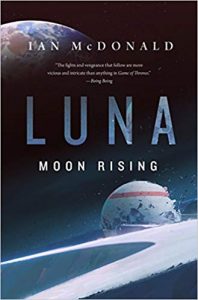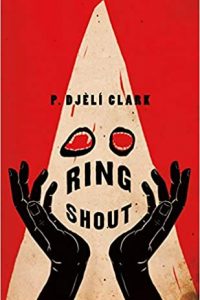Russell Letson Reviews Luna: Moon Rising by Ian McDonald
 Luna: Moon Rising, Ian McDonald (Tor 978-0765391476, $29.99, 448pp, hc) March 2019.
Luna: Moon Rising, Ian McDonald (Tor 978-0765391476, $29.99, 448pp, hc) March 2019.
If Ian McDonald’s Luna sequence is a trilogy (or, as I see it, a single triple-decker novel), then Luna: Moon Rising is the final volume, since it completes the large-cast, multi-threaded, braided story arc that began with Luna: New Moon (2015) and continued in Luna: Wolf Moon (2017). On the other hand, this capacious, busy, fictional story space could be extended indefinitely to follow humankind (if not this particular set of characters) into a strange, wonderful, and scary future history. (We will return to this notion later in the column.) Even if McDonald does decide to stop here, the Luna triptych will remain a wild ride through a world that is simultaneously familiar and unsettlingly new, and one of the most compelling SF creations of recent years.
The first two volumes followed the combination of business rivalries and blood feuds that pitted the family-based Dragons – the dominant industrial organizations that exploit lunar resources – against each other. Mackenzie Metals took down and absorbed the Corta Hélio helium-mining business, and the Cortas struck back savagely. Surviving heir Lucas Corta has been to Earth and back (a trip that nearly killed him) and has managed to become the Eagle – the nominal executive figure – of the Moon. Now those destructive feuds and disruptions have given the Earthly powers of the LMA (the Lunar Mandate Authority) an opening to assert themselves in ways that threaten the independence of lunar life, while the remaining Dragons look at new, game-changing enterprises of their own.
The book opens ten days after the catastrophic end of the previous volume, with the party taking nine-year-old Luna Corta and the all-but-lifeless body of her teenage brother Lucasinho to safety facing a paramilitary force sent by the rival Mackenzie clan, who are in turn surrounded by Corta loyalists. The fight that follows is a preview of events that fill the rest of the book: lightning fast, relentless, and merciless, even when there is nothing to be gained except the destruction of enemies.
A body falls. A figure in a sasuit twists and goes down. A shell-suit splinters into flying shards. The Mackenzie guns have opened up. A helmet shatters. A head flies into bloody smash; the banners of Dona Luna fall, one by one. Now Luna sees the blood, the plugs of flesh, the body fluids gouting into vacuum.
That is one side of the world humans have built on the moon. What began as an industrial colony has evolved into a new culture, where ingenious technologies fend off a deadly physical environment and support an exotic mixture of oligarchy, late-capitalist enterprise, and anarcho-libertarianism. This Luna is clannish (literally) and competitive to the point of murder and warfare, simultaneously socially free and physically and economically constrained. That social freedom has given rise to an explosion of interpersonal, artistic, cultural, and amatory arrangements, driven by the mixture of ethnicities and cultures that have formed this new society, as signaled by the languages that fill the book’s Glossary: Chinese, Portuguese, Russian, Yoruba, Spanish, Arabic, Akan – plus a calendar with Hawaiian day-names. The moon harbors the darkest and brightest sides of the human character: ruthlessness, ferocity, even bloodlust, as well as music and cuisine and several varieties of spirituality – creativity and carnaval on one side and assassination and mass murder on the other.
Cast members who have survived the convulsions of the earlier books find themselves in much-altered circumstances, particularly the Cortas. Lucas may have managed to become an independent power, but other Cortas and their allies are less secure. Lucasinho is perhaps brain-dead after saving Luna’s life (they hope he’ll get better), and his little sister has become his fiercest protector. Matrimonial lawyer Ariel Corta, left paraplegic and marginalized by the near-destruction of the family, is now alone, since her bodyguard/assistant Marina has returned to Earth. For her part, Marina is finding readjustment to her homeworld emotionally as well as physically difficult. Bipolar “wolf” Wagner has accepted responsibility for his nephew Robson, a duty that keeps him from his pack and thus from emotional peace. Much of the story deals with inter- and intra-familial struggles over control or at least custody of Lucashino and Robson, who are both hostages and future hopes in clan politics.
We also see a (literal) different side of lunar culture: the “third power, the hidden blade,” the University of Farside, which is “a nickname, though… an accurate one.” Not a single institution but a gaggle of interrelated groups given over to research and scholarship, perhaps even more libertarian-independent than the Dragon-led clans, their interests are guarded by ghazis, scholar-warriors, “ninja-academics” with whom one does not mess, as demonstrated by the skill-set of the fearsome Dr. Dakota Kaur Mackenzie:
We are taught to observe in minute detail, to exercise subtle psychological manipulation, to investigate, gather information and undertake covert operations. We learn all the major languages of the moon…. and psychological and performance skills. We learn coding, hacking, systems engineering…. We learn to design custom narcotics, poisons, hallucinogens. We are taught to seduce, to be seduced, to use sex as a weapon with anyone of any gender or none. I can survive seven minutes without oxygen.
Those individual storylines are quite compelling, not only for themselves but as part of the fractally unfolding portrait of this future, this world, this cultural matrix. In fact, I was so taken by following the agendas of various cast members (established and new) that I didn’t ask, “What is the main plot here?” for quite a while – perhaps a third of the way through. Then the gears of the individual story lines started to mesh and the outlines of the greater machine started to emerge, a familiar drama of a colony exerting its independence from the powers that established it. More is at stake than the status of the Corta family or the settling of scores among and between the Dragons.
Luna: Moon Rising provides a finish for some continuing characters (quite emphatically in a couple of cases), settles some long-running feuds (ditto), and points the way out of some of the seemingly intractable conflicts and tensions that have been stressing the lunar – indeed, the human – sociopolitical environment. It also includes a series of striking set-piece sequences, not all of which involve bloodshed (carnaval!). I have noted in earlier reviews that the books’ promotional copy often points to Game of Thrones – and fair enough, but I would go back farther. The spirits that I feel hovering over this expansive, inventive, immersive triptych are those of Heinlein, Alfred Bester, and Frank Herbert, with perhaps just a dash of Theodore Sturgeon and Samuel R. Delany. With godparents like that, how could the child not be wild and wonderful and just a bit scary?
Russell Letson, Contributing Editor, is a not-quite-retired freelance writer living in St. Cloud, Minnesota. He has been loitering around the SF world since childhood and been writing about it since his long-ago grad school days. In between, he published a good bit of business-technology and music journalism. He is still working on a book about Hawaiian slack key guitar.
This review and more like it in the April 2019 issue of Locus.
 While you are here, please take a moment to support Locus with a one-time or recurring donation. We rely on reader donations to keep the magazine and site going, and would like to keep the site paywall free, but WE NEED YOUR FINANCIAL SUPPORT to continue quality coverage of the science fiction and fantasy field.
While you are here, please take a moment to support Locus with a one-time or recurring donation. We rely on reader donations to keep the magazine and site going, and would like to keep the site paywall free, but WE NEED YOUR FINANCIAL SUPPORT to continue quality coverage of the science fiction and fantasy field.







